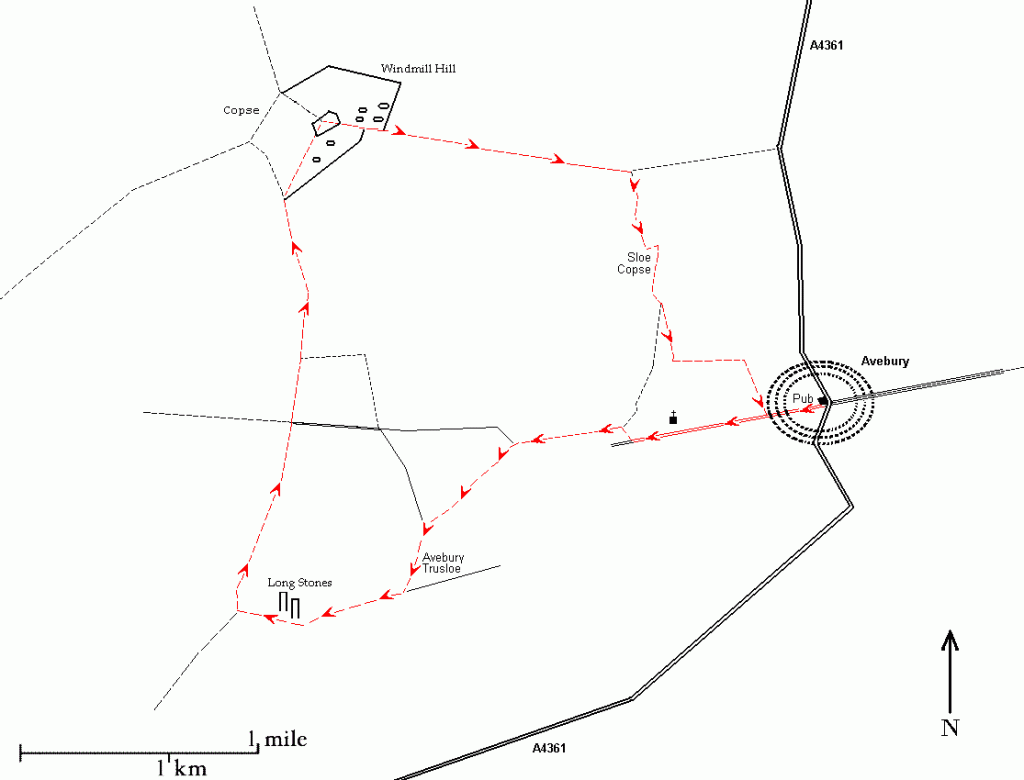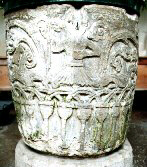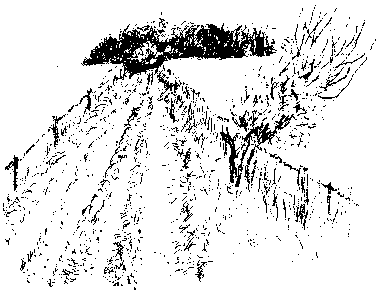Route: Avebury – Avebury Trusloe – Windmill Hill – Avebury
Length: 4½ miles
The best map is OS Explorer 157 or Landranger 173.
From Avebury car park follow the path towards the village where all the usual slightly twee but not outrageous fare of the National Trust type is available and get a leaflet or two and set about examining the great stone henges that dominate the place. Go west along the high street past the Church of St James on your right towards Avebury Trusloe. The church is of Anglo-Saxon origin and the village itself, though located in the middle of an ancient henge, is claimed to be Saxon too. But then again, all English villages are described as Anglo-Saxon in origin. One wonders where everybody lived before the Anglo-Saxons came over. Up trees? In caves? In the attics of Roman villae? You have to hand it to the Anglo-Saxons who, with an entire country to choose from, decided to build a village in the middle of somebody else’s henge. The church of St. James is at the western end of the Avebury complex and the churchyard is surrounded by a rookery. It contains a twelfth-century font showing two dragons bowing to a figure with a staff in one hand and a book in the other. The dragon-taming holy man is presumably St. James.
At the end of the high street you reach Avebury Trusloe where you take the signed footpath on the left that cuts between the backs of some houses and onto a small road. In the middle of a field on the right you will pass two stones, small in comparison to the ones in Avebury but so many stones have been broken up it is impossible to tell what their original size and shape would have been, though in this area minor sarsens seem to survive agricultural practices. The name Trusloe (now Avebury Trusloe) is a clue that sloe trees were a defining local feature. The Gaelic for sloe is DRAIGHEAN, or DRAIGHEÁN, which would appear to be a reference (albeit a rather mysterious one) to the ‘Dragon Line’ name. Trouse means cut thorn and Trusloe as a place where sloe thorn was cut makes sense (in Welsh trosol is the sort of crow you use as in crowbar). There is a lot of hawthorn here, the best time to see it is in May when the white blossoms magically soften its spikiness but even so it makes a vicious, dragon-like, barrier that can effectively protect the roots of trees from grazing animals. Walking sticks in Ireland, shillelaghs, are famously made of blackthorn.
Just past the stones turn right and follow the path round the perimeter of the field which joins up with a road heading north/north-west to Windmill Hill, a Neolithic enclosure overlooking Avebury. Notice that the crest of the hill is marked by a copse. As you walk, notice also a conspicuous copse on your left to the north-east; marked as ‘Sloe Copse’ on the OS map. Sloe berries are a traditional source of alcoholic drinks, though sloe gin itself is a modern concoction. Cheap and cheerful alcohol can be made from any hedge-fruit but references to processed alcohol (anything other than basic cider, beer or fermented fruit) are always of great interest because the Megalithic System required high value/low volume goods to function effectively, and top quality alcohol would certainly qualify. Distilling plays such a central role in the development of modern science that it is likely sophisticated ancient alcoholic processes were an element of earlier human progress.[1]
Approach to Windmill Hill (map ref. SU 087714)
The copse on top of the hill ahead stands out as you approach from the south. Windmill Hill seems to have a special relationship with West Kennett long barrow as the two sites are intervisible and both predate Silbury Hill and the Avebury henges. It is likely that Windmill Hill was still in use during the early stages of building at Avebury. On the right of the path is a hawthorn, particularly useful to Megalithic planners as a hedge for keeping animals in (or out) and safeguarding strategic water sources. Hence hawthorn is considered unlucky. Haw is the same word as hag, both mean ‘hedge’. [2]
Just before the copse ahead is reached you will see a gate on the right which leads to Windmill Hill, a ‘Neolithic causewayed enclosure’ in archaeologists’ lingo. There is precious little of the enclosure to see, archaeological digs have led to the assumption that the site was only used in the summer months as no permanent houses have been located. Items dated around 3,500 BC were found to contain material sourced from the Lizard in Cornwall, North Wales and the Lake District. The round barrows were erected at a later date, c. 2,000 BC.
Bowl Barrow on Windmill Hill
Windmill Hill is above Avebury, with no obvious connection between the two sites. The route up to the hill follows the ridge and passes to the west of Avebury.
From Windmill Hill you go east and through a gate at the far end of the site. Keep the fence and its attendant hedge on your left as you go downhill (the path itself is not easy to see despite being part of the ‘White Horse Trail’) until you reach the valley bottom and a path on the right that more or less follows the stream southwards back to Avebury.
[1] The printing press developed from wine presses. Mead was proposed as the agent of European intellectual development by Levi-Strauss, quite soberly. Whisky may have been the catalyst for the Scottish Enlightenment; production of good quality scotch whisky increased enormously in the early eighteenth century but, in response to a rise in English taxes (Scotland had joined the Union in 1707), was consumed almost entirely by the home market. With the 1784 ‘Wash Act’ taxation on whisky fell considerably. So did Scotland’s intellectual boom.
[2] Hawthorn or Whitethorn is the May-tree, the only British tree specifically equated with a month. May is considered unlucky for marriage. Hermes’ mother is Maia. In Welsh folklore hawthorn is the tree sacred to Olwen which translates as ‘white track’, ôl meaning ‘track’ and wen meaning ‘white, fair’. Olwen in the Mabinogion is a goddess or princess whose footprints leave a path of white trefoil flowers. Whiteness and trackways are key Megalithic pointers and Olwen is Maia. She also seems to be another ‘Elen of the Hosts’, the Druid goddess of roads. Trefoils feature in heraldry, in particular the fleur de lys, the lily or flower of the Ys (isle), emblem of French monarchs par excellence. The water-lily, or lotus, was a sacred flower, most notably the blue lotus of Ancient Egypt, a flower with mysterious narcotic properties.




Leave a Reply